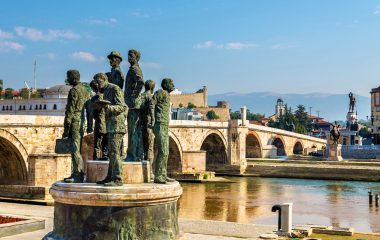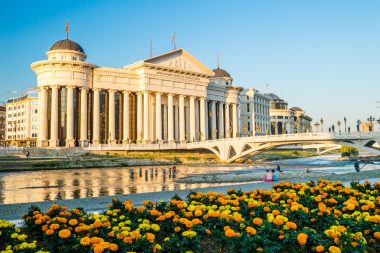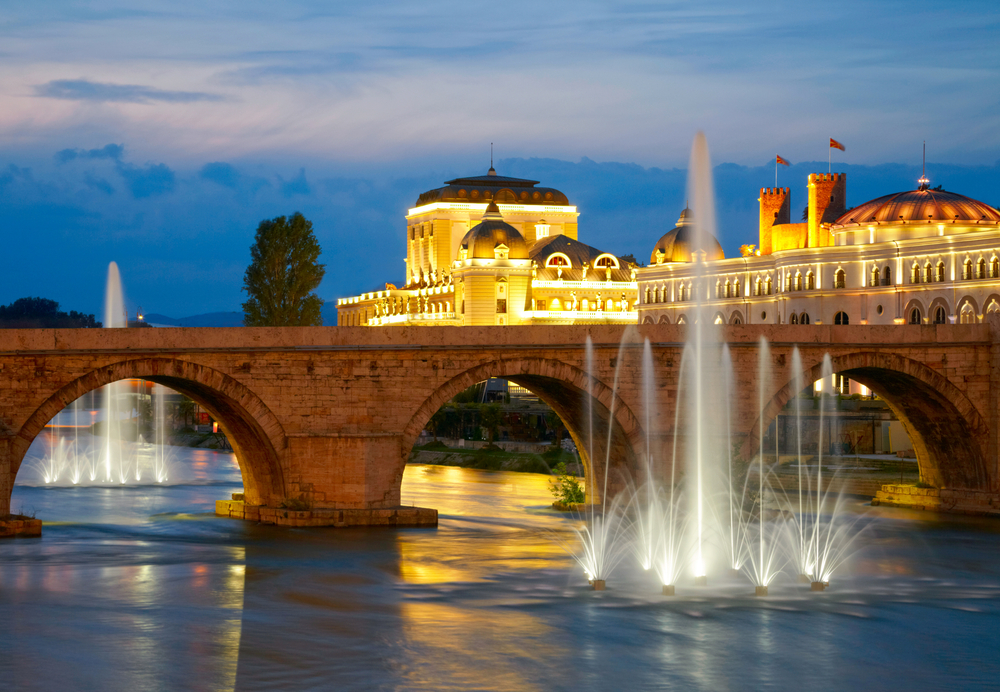The Skopje Summer Festival has been held annually in Skopje since 1979. A whole summer month full of art can be experienced, with music, theatrical performances, films, multimedia performances and much more, both open air and in halls.
But what attracts tourists to Skopje besides the festival? More on this below. First of all: A visit to the city is also worthwhile for museum lovers and music enthusiasts.
It is not of beguiling beauty like Paris or Rome, not a tourist magnet like London or Istanbul. Skopje is an extraordinary destination a bit off the beaten track. It is a city for explorers.
Skopje is the capital of the Balkan state of North Macedonia, located between Serbia, Bulgaria, Greece, Albania and Kosovo. This city, which is proud to be 2000 years old, looks back on an eventful history. It is multi-ethnic and multi-religious and offers a lot of interesting sights and culture if travelers are willing to get to know the unfamiliar and foreign.
Skopje is also home to the government and economic center of the country. Both the church (Orthodox Christianity) and the Islamic religious community (Sunnis) have their headquarters in the city.
Location of Skopje

Skopje is located in the north of the country, just under 20 kilometers from the border with Kosovo . The Vardar River meanders through the city, and Mount Vodno is in the immediate vicinity.
Climate and travel time Skopje
Wet and cold winters do not make a trip here at this time of year enjoyable. Summers, on the other hand, are warm and dry, giving the city an almost Mediterranean climate. April to October are good travel months; August and September offer ideal weather conditions.
History, sights and culture
Romans and Ottomans have left their mark, more recently the socialist regime of the former Yugoslavia.
The great earthquake of 1963 also changed the face of the city. The Eurasian and African plates collide here and cause tectonic activity that led to large earthquakes in 518, 1515 and 1963. The last one has reduced most of the old town to rubble, more than 1000 people lost their lives, three quarters of the population lost their homes. The reconstruction took only a few years and was realized with international help under the leadership of the Japanese architect Kenzo Tange.
Worth seeing and unique in its extent is the Roma settlement Shutka, a completely different world from the city centre of Skopje.
Travelers should not miss the bazaar, as well as the Museum of the Old Bazaar, housed in a 15th-century caravanserai, which displays photographs and maps from the period as well as goods from the Ottoman era.
Museums

The largest art collection in the country can be admired in the Museum of Contemporary Art .
On the site of the railway station, built in 1938 and destroyed by the earthquake of 1963, there is now a small gallery and museum of the city, which exhibits evidence of settlement, starting with the first traces of prehistoric times.
The Mother Teresa Memorial House reports on the life and work of the nun and Nobel Peace Prize winner and her humanist commitment.
In 1991, the Archaeological, Historical and Ethnological Museums merged to form the Museum of Macedonia. It is set up in an Ottoman building from the 16th century and displays exhibits, the oldest of which date back to antiquity, on an area of about 6000 square meters.
Adjacent to the zoo, the botanical garden and the city park is the Natural Science Museum , which houses about 4000 exhibits, mainly fossils, plants and insects.
Just as many exhibits from the realm of minerals, plants and animals can be found in the Natural History Museum.
Libraries, literature and theatres
The National and University Library in the city centre is the largest library in the country, with around 60,000 books, sheet music and magazines housed in the city library .
The Linden Festival, founded in 1997 by the Macedonian Writers’ Association, is considered one of the most important literary events in the country. It takes place every year in June during the lime blossom season. Macedonian and international authors participate.
The Open Youth Theatre Festival offers a platform for experimental performances and improvisational theatre of the young scene.
Music
The May Opera Evenings at the National Theatre are dedicated to classical music.
Do you prefer blues, soul, jazz? The Blues and Soul Festival takes place in July, the Skopje Jazz Festival in October.
Arrival and arrival
German nationals do not need a visa, only an identity card or passport. (As of June 2019)
There are many very inexpensive flights. Skopje Airport is located just outside the city, with which it is connected by low-cost buses or taxis for a maximum of 20 euros.
Otherwise, payment is made in Macedonian dinars. ATMs are available at the airport. North Macedonia does not belong to the EU and not to the European Monetary Union!
Skopje, the capital of the former Yugoslav Republic of North Macedonia, is several thousand years old. Visually, however, it appears only a few years young. The reason: In 1963, a major earthquake almost completely destroyed the city. The controversial “Skopje 2014” construction project gave the city a new face in neo-baroque and neoclassical style. For tourists, this means that the biggest attraction is the city of Skopje itself.
Skopje unites the whole world
Skopje is home to architectural highlights from all over the world in a very small space. The French L’Arc de Triomphe stands in a slightly smaller edition than the original, at the gateway to the heart of the city centre, Macedonia Square. Here the building is called Porta Makedonija. Visitors can get there on a red double-decker bus, which looks exactly like the more famous examples from London. And the Wall Street bull is represented as well as a huge edition of the Greek Alexander the Great.
This list could be continued endlessly. Skopje is teeming with sculptures depicting more or less world-famous personalities that were erected as part of the “Skopje 2014” urban renewal plan. A total of more than 70 sculptures cavort throughout the city center, with many artists and scholars populating the Art Bridge in front of the opera house. Spanned over the Vardar River, and located in a rather idyllic neighborhood of numerous bars and restaurants that offer a view of the bridge and monumental buildings on the opposite side of the river, it is a popular photo motif.
First functional, then chic
Just like the sculptures, the antique-looking buildings run through the entire city center, inviting you to take an architectural walk. After the great destruction of 1963, the city center of Skopje was rebuilt in exposed concrete using the Eastern European rapid construction method. It was functional, but it didn’t look very nice. The buildings in the socialist uniform gray are still standing. However, their facades are now clad and symbolize pomp and splendour. The best example of this is the seat of government of North Macedonia.
Formerly a purely functional building, visitors now believe they are in front of the White House in Washington. If you want to learn more about this sometimes absurd transformation of Skopje, from a disaster scene to a modern Disneyland, you can book a guided walking tour. Well-trained tour guides explain the background to the change in all kinds of foreign languages and also provide information about the political system and the social situation of the country.
Socialist Brutalism
Another highlight is the former main post office of Skopje, which was built in the 1970s in the style of socialist brutalism. It looks like a lotus flower made of concrete. A few years ago, there was a fire in the main hall of the post office. Since then, only the offices and an adjoining wing have been used as a post office. The main hall remains closed, but can be “visited” in an unchanged state for all those who dare to peek through the glass entrance door.
The Bit-Pazar
From there, cross the Stone Bridge, which has connected the two sides of the Vardar River since the 15th century, to the Old Bazaar, the Bit-Pazar. Here, many of the traders do not speak Macedonian, like the majority of the country, but Albanian. The Albanian minority, which makes up almost a quarter of the country’s population, is completely in its Muslim tradition here. Walkers are reminded of famous Ottoman bazaar streets. Small shops sell a lot of gold jewellery and Muslim traditional costumes.
Tea, Turkish coffee and sweets are available on every corner. A former hammam is now used as a museum. The five mosques in the area, such as the Mustafa Pasha Mosque, are accessible and some of them can be visited. In the garden of the Mustafa Pasha Mosque, photo or art exhibitions also take place from time to time.
Kale Fortress
In the immediate vicinity of the bazaar, the Kale fortress towers high above the old town. Or rather, what is left of it. Today, only the outer walls of the formerly stately fortress remain. These, however, are equipped with stones from the 6th century. Archaeological excavations have been taking place on the fortress grounds for years. The fortress wall can be walked on a circular path and offers a magnificent view over the old and new town.
Mother Teresa – the most famous daughter of the city of Skopje
Mother Teresa, who was born in Skopje in 1910 as a member of the Albanian minority, was world-famous. Anjezë Gonxhe Bojaxhiu, as her civil name is, grew up in poor circumstances. In her honour, the Mother Teresa Memorial House, along with the Roman Catholic Church, was built in 2008. Inside the memorial house, original furnishings from Mother Teresa’s childhood home can be seen. Some manuscripts and documents from her life, as well as numerous photos, also bring visitors closer to the work of the famous saint.
Excursion to the local mountain Vodno
Don’t miss a trip to Skopje’s local mountain, Vodno. From the city centre, the mountain can be hiked within about three hours. The path leads through quite steep forests, which offer views halfway along the route. If you are not so good on foot, take the red double-decker bus to the middle of the Vodno. From there, a cable car leads to the summit. Once there, you look far down on the city, and only here you realize how long it nestles completely left and right against the Vardar River. From the summit cross of Vodno, numerous hiking trails to the surrounding mountains and canyons can be chosen. But be careful: there are still bears in North Macedonia.


